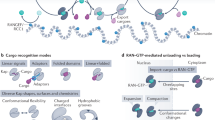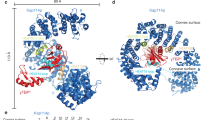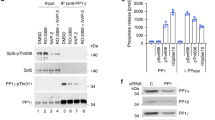Abstract
The movement of many transcription factors, kinases and replication factors between the nucleus and cytoplasm is important in regulating their activity1. In some cases, phosphorylation of a protein regulates its entry into the nucleus2; in others, it causes the protein to be exported to the cytoplasm3,4,5,6. The mechanism by which phosphorylation promotes protein export from the nucleus is poorly understood. Here we investigate how the export of the yeast transcription factor Pho4 is regulated in response to changes in phosphate availability. We show that phosphorylation of Pho4 by a nuclear complex of a cyclin with a cyclin-dependent kinase, Pho80–Pho85, triggers its export from the nucleus. We also find that the shuttling receptor used by Pho4 for nuclear export is the importin-β-family member Msn5 (refs 7, 8), which is required for nuclear export of Pho4 in vivo and binds only to phosphorylated Pho4 in the presence of the GTP-bound form of yeast Ran in vitro. Our results reveal a simple mechanism by which phosphorylation can control the nuclear export of a protein.
This is a preview of subscription content, access via your institution
Access options
Subscribe to this journal
Receive 51 print issues and online access
$199.00 per year
only $3.90 per issue
Buy this article
- Purchase on Springer Link
- Instant access to full article PDF
Prices may be subject to local taxes which are calculated during checkout




Similar content being viewed by others
References
Nigg, E. A. Nucleocytoplasmic transport: signals, mechanisms and regulation. Nature 386, 779–787 (1997).
Jans, D. A. & Hubner, S. Regulation of protein transport to the nucleus: central role of phosphorylation. Physiol. Rev. 76, 651–685 (1996).
Timmerman, L. A., Clipstone, N. A., Ho, S. N., Northrop, J. P. & Crabtree, G. R. Rapid shuttling of NF-AT in discrimination of Ca2+ signals and immunosuppression. Nature 383, 837–840 (1996).
Shibasaki, F., Price, E. R., Milan, D. & McKeon, F. Role of kinases and the phosphatase calcineurin in the nuclear shuttling of transcription factor NF-AT4. Nature 382, 370–373 (1996).
De Vit, M. J., Waddle, J. A. & Johnston, M. Regulated nuclear translocation of the Mig1 glucose repressor. Mol. Biol. Cell 8, 1603–1618 (1997).
Gorner, W. et al. Nuclear localization of the C2H2 zinc finger protein Msn2p is regulated by stress and protein kinase A activity. Genes Dev. 12, 586–597 (1998).
Fornerod, M. et al. The human homologue of yeast CRM1 is in a dynamic subcomplex with CAN/Nup214 and a novel nuclear pore component Nup88. EMBO J. 16, 807–816 (1997).
Gorlich, D. et al. Anovel class of RanGTP binding proteins. J. Cell Biol. 138, 65–80 (1997).
Kaffman, A., Herskowitz, I., Tjian, R. & O'Shea, E. K. Phosphorylation of the transcription factor PHO4 by a cyclin–CDK complex, PHO80–PHO85. Science 263, 1153–1156 (1994).
O'Neill, E. M., Kaffman, A., Jolly, E. R. & O'Shea, E. K. Regulation of PHO4 nuclear localization by the PHO80–PHO85 cyclin–CDK complex. Science 271, 209–212 (1996).
Oshima, Y. The phosphatase system in Saccharomyces cerevisiae. Genes Genet. Syst. 72, 323–334 (1997).
Ogawa, N. et al. Functional domains of Pho81p, an inhibitor of Pho85p protein kinase, in the transduction pathway of Pi signals in Saccharomyces cerevisiae. Mol. Cell. Biol. 15, 997–1004 (1995).
Schneider, K. R., Smith, R. L. & O'Shea, E. K. Phosphate-regulated inactivation of the kinase PHO80–PHO85 by the CDK inhibitor PHO81. Science 266, 122–126 (1994).
Kaffman, A., Rank, N. M. & O'Shea, E. K. Phosphorylation regulates association of the transcription factor Pho4 with its import receptor Pse1/Kap121. Genes Dev. 12, 2673–2683 (1998).
Lee, M. S., Henry, M. & Silver, P. A. Aprotein that shuttles between the nucleus and the cytoplasm is an important mediator of RNA export. Genes Dev. 10, 1233–1246 (1996).
Wimmer, C., Doye, V., Grandi, P., Nehrbass, U. & Hurt, E. C. Anew subclass of nucleoporins that functionally interact with nuclear pore protein NSP1. EMBO J. 11, 5051–5061 (1992).
Nehrbass, U. et al. NSP1: a yeast nuclear envelope protein localized at the nuclear pores exerts its essential function by its carboxy-terminal domain. Cell 61, 979–989 (1990).
Doye, V., Wepf, R. & Hurt, E. C. Anovel nuclear pore protein Nup133p with distinct roles in poly(A)+ RNA transport and nuclear pore distribution. EMBO J. 13, 6062–6075 (1994).
Aitchison, J. D., Blobel, G. & Rout, M. P. Kap104p: a karyopherin involved in the nuclear transport of messenger RNA binding proteins. Science 274, 624–627 (1996).
Xiao, Z., McGrew, J. T., Schroeder, A. J. & Fitzgerald-Hayes, M. CSE1 and CSE2, two new genes required for accurate mitotic chromosome segregation in Saccharomyces cerevisiae. Mol. Cell. Biol. 13, 4691–4702 (1993).
Stade, K., Ford, C. S., Guthrie, C. & Weis, K. Exportin 1 (Crm1p) is an essential nuclear export factor. Cell 90, 1041–1050 (1997).
Seedorf, M. & Silver, P. A. Importin/karyopherin protein family members required for mRNA export from the nucleus. Proc. Natl Acad. Sci. USA 94, 8590–8595 (1997).
Rout, M. P., Blobel, G. & Aitchison, J. D. Adistinct nuclear import pathway used by ribosomal proteins. Cell 89, 715–725 (1997).
Kadowaki, T. et al. Isolation and characterization of Saccharomyces cerevisiae mRNA transport-defective (mtr) mutants. J. Cell Biol. 126, 649–659 (1994).
Arts, G. J., Fornerod, M. & Mattaj, I. W. Identification of a nuclear export receptor for tRNA. Curr. Biol. 8, 305–314 (1998).
Kutay, U., Bischoff, F. R., Kostka, S., Kraft, R. & Gorlich, D. Export of importin alpha from the nucleus is mediated by a specific nuclear transport factor. Cell 90, 1061–1071 (1997).
Kutay, U. et al. Identification of a tRNA-specific nuclear export receptor. Mol. Cell 1, 359–369 (1998).
Fornerod, M., Ohno, M., Yoshida, M. & Mattaj, I. W. CRM1 is an export receptor for leucine-rich nuclear export signals. Cell 90, 1051–1060 (1997).
Bischoff, F. R., Klebe, C., Kretschmer, J., Wittinghofer, A. & Ponstingl, H. RanGAP1 induces GTPase activity of nuclear Ras-related Ran. Proc. Natl Acad. Sci. USA 91, 2587–2591 (1994).
Chenevert, J., Valtz, N. & Herskowitz, I. Identification of genes required for normal pheromone-induced cell polarization in Saccharomyces cerevisiae. Genetics 136, 1287–1296 (1994).
Acknowledgements
We thank I. Herskowitz, J. Li, J. Weissman and members of the O'Shea laboratory for comments on the manuscript; R. Bischoff for the RanQ69L plasmid; M. Lenburg for the Pho85–GFP plasmid; and J. Aitchison, K. Weis, P. Silver, M. Fitzgerald-Hayes, E. Hurt and A. Tartakoff for yeast strains. A.K. is a Fellow of the UCSF Medical Scientist Training Program. N.M.R. and L.S.H. were supported by fellowships from the NIH and E.M.O. was supported by a fellowship from the Jane Coffin Childs Foundation. This work was supported by the David and Lucile Packard Foundation and by an NSF Presidential Faculty Fellowship (E.K.O.).
Author information
Authors and Affiliations
Corresponding author
Rights and permissions
About this article
Cite this article
Kaffman, A., Rank, N., O'Neill, E. et al. The receptor Msn5 exports the phosphorylated transcription factor Pho4 out of the nucleus. Nature 396, 482–486 (1998). https://doi.org/10.1038/24898
Received:
Accepted:
Issue Date:
DOI: https://doi.org/10.1038/24898
This article is cited by
-
Quantitative analysis of phosphate accumulation in PHO regulatory system-mutant strains of Saccharomyces cerevisiae
Archives of Microbiology (2023)
-
Identification of acetic acid sensitive strains through biosensor-based screening of a Saccharomyces cerevisiae CRISPRi library
Microbial Cell Factories (2022)
-
CRZ1 transcription factor is involved in cell survival, stress tolerance, and virulence in fungi
Journal of Biosciences (2022)
-
A TFEB nuclear export signal integrates amino acid supply and glucose availability
Nature Communications (2018)
-
Dissection of differential vanadate sensitivity in two Ogataea species links protein glycosylation and phosphate transport regulation
Scientific Reports (2018)
Comments
By submitting a comment you agree to abide by our Terms and Community Guidelines. If you find something abusive or that does not comply with our terms or guidelines please flag it as inappropriate.



